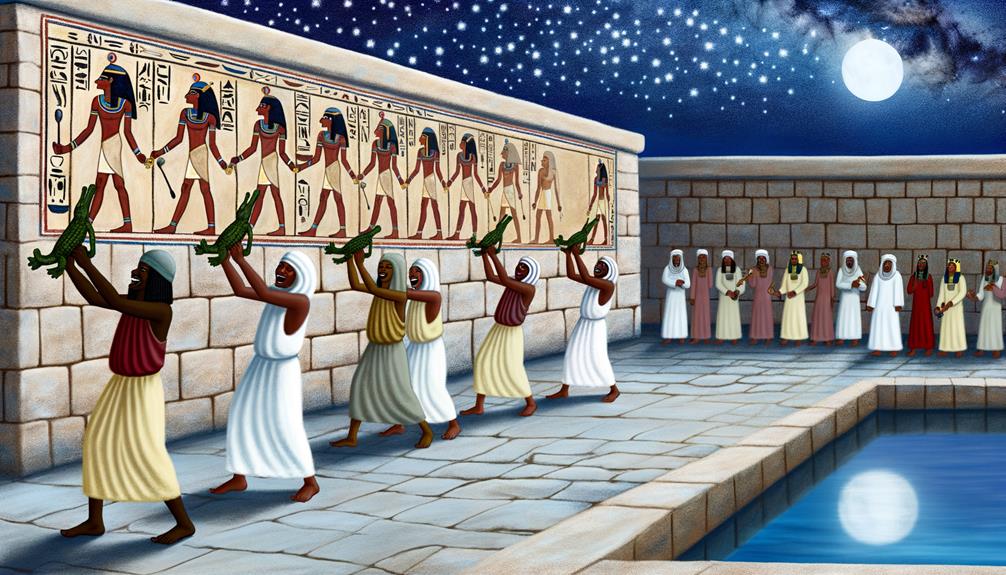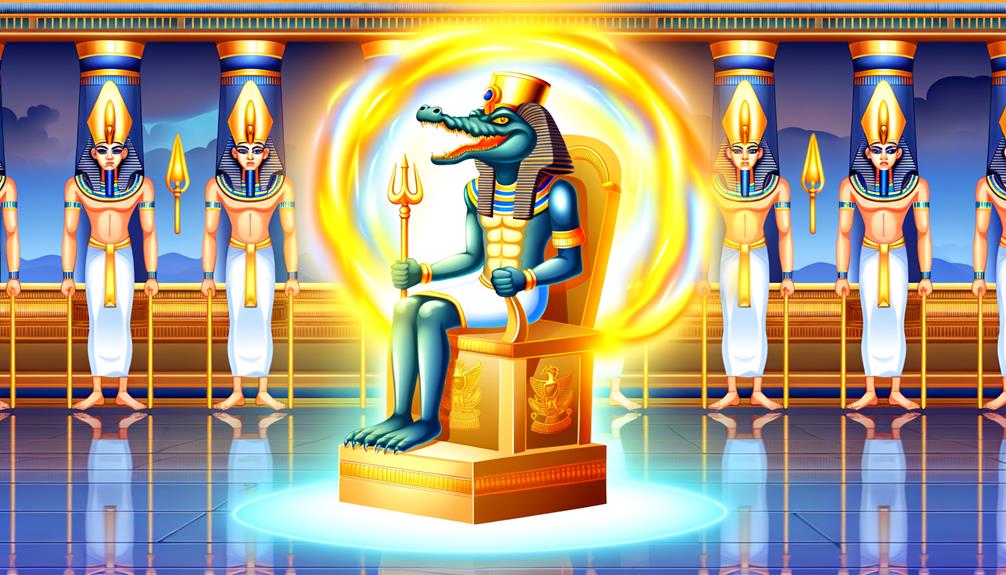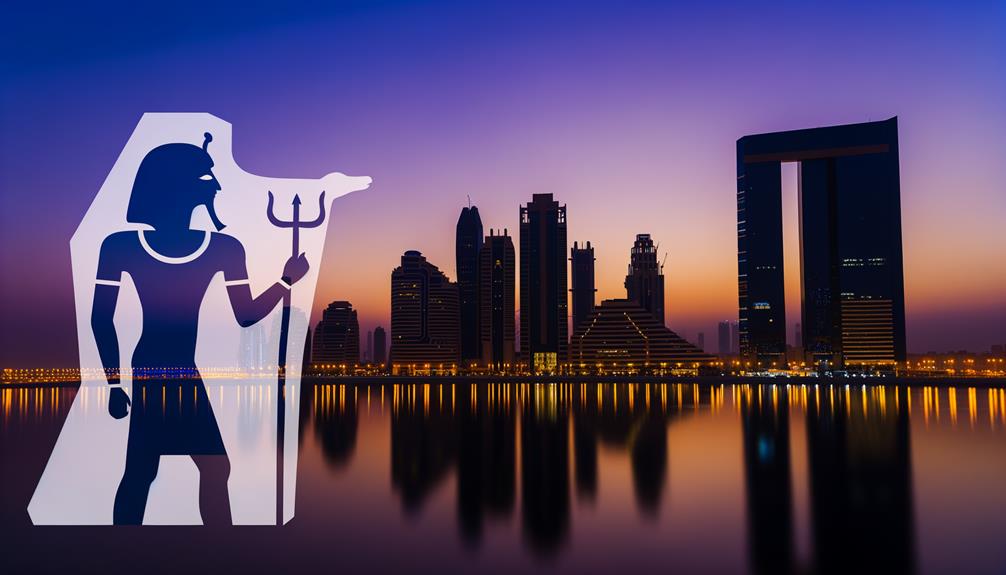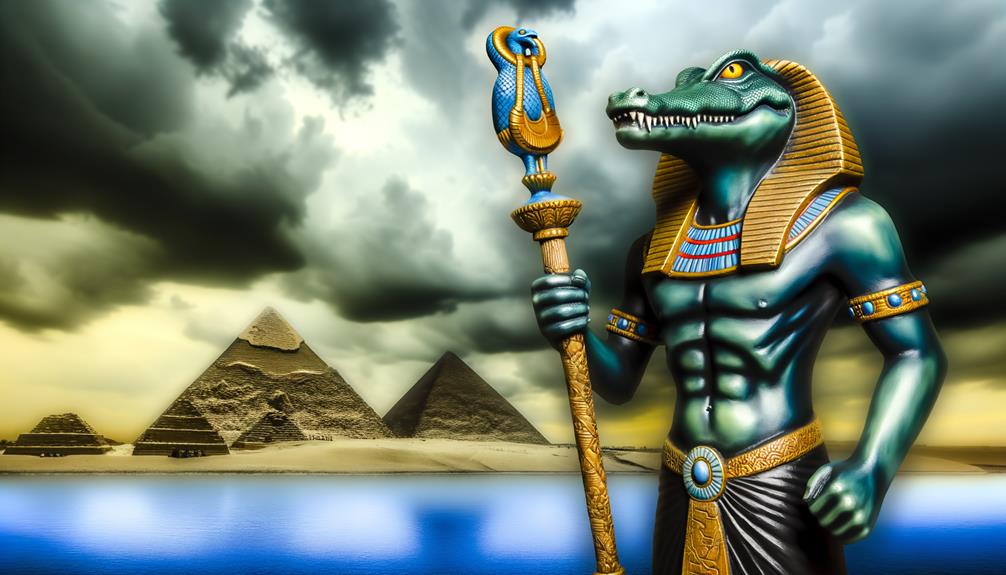Imagine a crocodile, lurking beneath the water's surface, ready to show its mighty strength. This image brings us close to understanding the ancient Egyptian deity Sobek, the Crocodile God. This fearsome figure held an impressive and complex influence within the culture of the Nile inhabitants. I've spent time getting to know Sobek's multifaceted nature, revealing his impressive sway over elements of fertility, virility, and protection.
Often represented as a full crocodile or a man with a crocodile's head, Sobek was revered as the creator of the Nile. In addition, he was seen as a symbol of the river's unpredictable and occasionally harsh character. But Sobek's might isn't just about his fearsome side. His power has more layers and depths to it than just the intimidating respect generated by his forceful side.
In the ancient cities where Sobek was worshipped, from Shedyet to Nubt, there's a story of divine strength waiting to be shared. It's a story that's been whispered in the shadows of these religious centers. This is the story I want to share with you, a tale of divine power that goes far beyond what you might expect. This story, like the crocodile lurking beneath the surface, is waiting to show its true might.
Origin and Symbolism of Sobek

Let's talk about Sobek, a god from ancient Egypt whose influence can be followed from the Old Kingdom right up to the Roman period. Historical records like the Pyramid Texts confirm this. Sobek first showed up during the Old Kingdom, but it was in the Middle Kingdom, especially under Amenemhat III's rule, when he really started to shine.
People often discuss and argue about Sobek's beginnings and what he represents. But one thing is certain; Sobek was more than just a god to the ancient Egyptians. He was a symbol of divine royalty. He was seen as a protector and a healer, embodying the strength and fierceness of a crocodile. This connection to crocodiles wasn't random. It shows how much the ancient Egyptians respected – and feared – these animals.
Sobek's character also gets more complex when you consider how he merged with other gods, like Horus and Ra. These combinations added more depth to his character and what he symbolized. They show how important Sobek was in maintaining the universe's balance. Sobek's followers, particularly in the Faiyum region, and his main worship center, Crocodilopolis, highlight his long-lasting impact on ancient Egyptian society.
Sobek's Divine Family Connections
Let's dive into the divine family ties of Sobek, which connect him to other noteworthy gods such as Set, his father, who symbolizes thunder, storms, war, and chaos, and Neith, his mother, who represents war, hunting, and wisdom. Sobek, the crocodile god, was a mighty figure in the pantheon. His spouse, Renenutet, the goddess of abundance, further strengthens Sobek's divine family bonds.
| Family Member | Association |
|---|---|
| Set | Father |
| Neith | Mother |
| Renenutet | Wife |
| Khonsu | Likely Son |
| Horus | Closely Associated Deity |
Sobek also had connections with Hathor, Heqet, and Taweret, among others. Sobek's worship became quite popular, with centers in places like Shedyet, Nubt, and Karanis. A close link existed between Sobek and Horus, with Sobek often seen as a form of Horus. As a result, Sobek's name became synonymous with power and protection. Sobek, the crocodile god, truly stands as a powerful symbol of strength, held in high regard in his unique divine family structure.
Worship Centers and Rituals

Let's take a stroll through the captivating world of ancient Egyptian worship, specifically focusing on the deity Sobek. We'll start our journey in the Faiyum region, home to the famous Crocodilopolis, and move on to the cult center of Karanis during the Roman rule. In these significant locations, the reverence for Sobek was deep and profound, with rituals that centered on a live crocodile named Petsuchos. This was no ordinary crocodile – it was seen as a physical embodiment of Sobek himself.
A few highlights of Sobek's worship included:
- The dedicated priests of Sobek, who not only cared for the sacred Petsuchos but also went to the extent of feeding and decking out the crocodile in jewels.
- The mummified crocodiles, which were given as offerings and are presently a major attraction at the Crocodile Museum.
- The Temple of Kom, a place where Sobek was worshipped alongside Hathor and Khonsu, together making up the Triad of Kom Ombo.
These centers were the venues for grand ceremonies dedicated to Sobek, with the main aim of appeasing the deity's power. Even today, the influence of Sobek's worship can be seen in the preserved temples and mummified crocodiles, serving as a testament to the intricate rituals and the deep-rooted belief in Sobek's divine power by the ancient Egyptians.
Sobek's Role in Egyptian Pantheon

Let's talk about Sobek, the crocodile god, and his remarkable role in the Egyptian pantheon that evolved from the Old Kingdom to the Roman period. Known for his power and fertility, Sobek was a figure of great respect in the Faiyum region and the town of Crocodilopolis. When we look back at the Middle Kingdom, during the rule of Amenemhat III, as many as 77 crocodiles were mummified in Sobek's honor. It's a fascinating testament to his growing influence at the time.
But Sobek wasn't just a symbol of strength and fertility. People also saw him as a sun god, an image that captures his assertive and protective character. He was closely linked with healing, and he was a deity who inspired both respect and fear. And if we want to really grasp his role, we need to look at his connection with Horus. When they were combined, they created Sobek-Horus, a multi-faceted deity that represented the power of the Egyptian gods.
Sobek's cult didn't fade away in the Ptolemaic and Roman periods. In fact, it thrived, particularly in the temple of Kom Ombo. This temple, which was dedicated to both Horus and Sobek, is a clear sign of the lasting respect and admiration for the crocodile god in the Egyptian pantheon.
Sobek's Influence in Modern Culture

Sobek, the ancient Egyptian god, may have been worshipped thousands of years ago, yet his presence continues to ripple through our modern world. The mighty crocodile god, a symbol of power, protection, and fertility, still holds sway in our collective consciousness.
Take a stroll through the Metropolitan Museum, and you'll come across a statue dating back to 1991-1802 BCE. It features Sobek alongside Anubis, a testament to his enduring influence on art through the centuries.
If you're into video gaming, you might have encountered Sobek in 'Smite.' There, he's portrayed with a crocodile head, a nod to his formidable power.
In today's spiritual practices, too, Sobek's essence is often called upon. He's seen as a representation of raw strength and protection.
These examples underscore our ongoing intrigue with Sobek. They show how we're still weaving the myth of this crocodile-headed god into our current cultural tapestry. Be it a museum piece, a video game avatar, or a symbol in contemporary spirituality, the footprint of Sobek, just like the enduring Nile crocodile, remains potent in our world today.
Frequently Asked Questions
What Is Sobek's Power?
As Sobek, the god, people look up to me for my influence over water, my ability to promote growth, and my skill in warfare. I'm known as a guardian deity, a figure of power and strength that can be intimidating, but also greatly respected. My power lies not just in raw strength, but in my capacity to maintain harmony and equilibrium.
What Was Sobek's Job?
Sobek had quite a few responsibilities. He was the one who kept pharaohs and people safe, managed the fertility of the Nile, and was in charge of the army's might. His main job, though, was to make sure the Nile remained plentiful, to keep the kingdom secure, and to represent divine power.
Is Sobek a Good God?
Sure, in my eyes, Sobek is definitely a noteworthy deity. He's often admired for his role as a guardian, supplying power and serving as a pillar of support in face of difficulties. Plus, his association with the ever-important Nile signifies life's abundance and fruitfulness, and that makes him an indispensable character in the annals of ancient Egypt.
What Weapon Does Sobek Use?
You might be curious about the weapon of choice for Sobek, right? Well, let me tell you, it's a truly grand, ceremonial axe. This isn't just any old axe, either. It stands as a testament to his tremendous might, bravery, and dominion. Picture an axe that not only represents his raw ferocity, but also his royal qualities and his place as the guardian of pharaohs. Plus, he's not just about protection. Sobek is the go-to guy for the Egyptian army, serving as their patron. Now that's what I call a powerful symbol!

